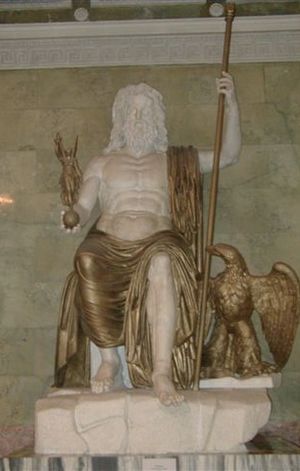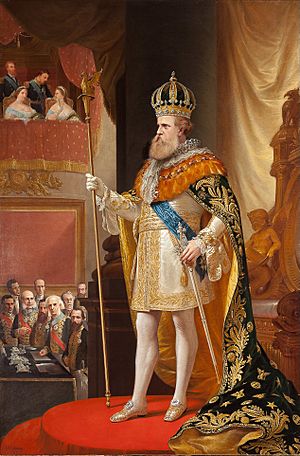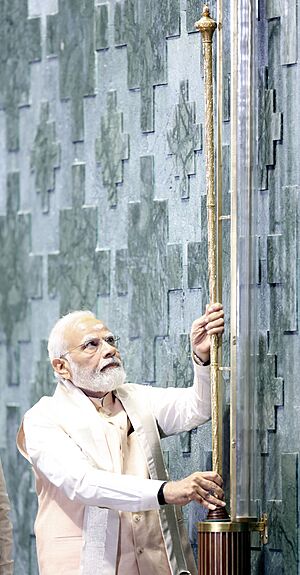Sceptre facts for kids
A sceptre (pronounced SEP-ter) is a special staff or wand. Kings, queens, and emperors hold it in their hand. It's a symbol of their power and authority. It shows they are the ruler of a country or empire.
Contents
Sceptres in Ancient Times

Ancient Egypt and Mesopotamia


In Ancient Egypt, special staffs called Was were signs of power. They were like sceptres, even if they were long staffs. One of the oldest royal sceptres was found in the tomb of King Khasekhemwy. This king lived about 4,700 years ago. Pharaohs, who were Egyptian kings, also carried staffs. The heqa-sceptre, shaped like a shepherd's crook, was very important.
Sceptres were also key symbols in Mesopotamia, an ancient region in the Middle East. Kings and gods often held them. This was true throughout Mesopotamian history. The sceptre was called ĝidru in the Sumerian language and ḫaṭṭum in the Akkadian language.
The Bible also mentions sceptres. In the Book of Genesis, it talks about the sceptre of Judah. It says, "The sceptre shall not depart from Judah... until Shiloh come." This means Judah would always have a ruler. The Book of Esther also mentions the sceptre of the King of Persia. It says the king held out his golden sceptre to Queen Esther.
Greece and Rome
In Ancient Greece, a sceptre was a long staff. Important people like judges, military leaders, and priests used it. It was often shown on painted vases with a metal top. When the god Zeus or Hades held a sceptre, it had a bird on top. Zeus was the king of the gods. His sceptre made heralds (messengers) untouchable. This was like early diplomatic immunity.
The Etruscans, an ancient people in Italy, also used grand sceptres. Their kings and high priests had them. Many Etruscan sceptres were made of gold. They were decorated with tiny details.
The Roman sceptre likely came from the Etruscans. In the Roman Republic, an ivory sceptre was a sign of a consul (a top official). Victorious generals also used it. Under the Roman Empire, emperors used the sceptrum Augusti. This was often an ivory sceptre with a golden eagle on top. Emperors were often shown holding it with an orb (a ball with a cross) in the other hand.
Sceptres in Ancient India
Ancient Indian texts also talk about sceptres. The Tirukkural, a Tamil work from before the 5th century CE, discusses "just" and "cruel" sceptres. It says a king's good rule, not his spear, connected him to his people. The text calls a just sceptre "Sengol" in Tamil. Ancient Indian kingdoms, like the Chola kings, used a symbolic sceptre during coronations.
One such sceptre, the Sengol, was given to India's first Prime Minister, Jawaharlal Nehru, in 1947. This symbolized the transfer of power from British rule to India. In 2023, the Indian government placed this golden sceptre in the new Indian Parliament building.
Sceptres in Christian Kingdoms

When Christianity became widespread, sceptres often had a cross on top instead of an eagle. But during the Middle Ages, the tops of sceptres varied a lot.
In England, two sceptres have been used together for a long time. Since the time of Richard I, one has a cross on top, and the other has a dove. In France, the royal sceptre had a fleur de lys (a lily flower symbol). Another French sceptre, called the main de justice, had an open hand on top.
Some sceptres had small shrines on top. One of the sceptres of Scotland, kept in Edinburgh, has such a shrine. It has tiny figures of the Virgin Mary, Saint Andrew, and Saint James the Great. This sceptre was likely made in France around 1536 for James V.
Old royal seals often show the ruler holding a sceptre in one hand and an orb with a cross in the other. Harold Godwinson, an English king, is shown this way in the Bayeux Tapestry.
The earliest English coronation records from the 9th century mention a sceptre and a staff. For the coronation of Richard I, a golden sceptre with a cross and a golden rod with a dove were first recorded. These were used for coronations until the Commonwealth period (around 1649), when they were destroyed.
For the coronation of Charles II of England, new sceptres with the Cross and the Dove were made. These are still used today. Two more sceptres were later made for the queen consort (the king's wife), one with a cross and one with a dove.
The flags of Moldova and Montenegro show eagles holding sceptres.
See also
 In Spanish: Cetro para niños
In Spanish: Cetro para niños
- Axis mundi
- Baton
- Black Rod
- Bulawa
- Pernach
- Sengol
- Ceremonial mace
- Crown jewels
- Fool's sceptre
- Orb
- White Rod



